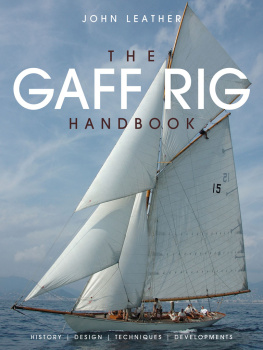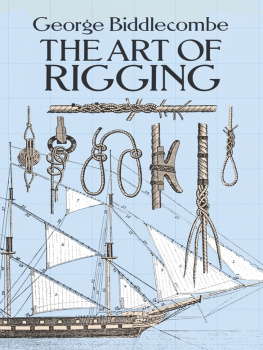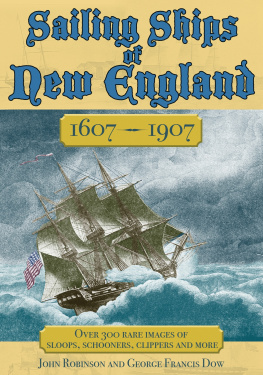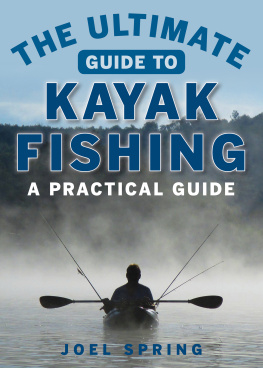Glory of the gaff rig.
The 158ft racing schooner Rainbow of 1898 sweeping through Cowes Roads setting 14,000 square feet.
Photo: Beken of Cowes

To the mariners and shipbuilders of Rowhedge
About the Author
JOHN LEATHER is descended from Lancashire and Essex maritime families whose background was shipbuilding, marine engineering, deep sea seafaring, and professional yachting. He is a naval architect by profession and has been involved with the design, construction and surveying of ships of many types, sizes and complexity throughout his career. He is a Fellow of the Royal Institution of Naval Architects and a Chartered Engineer. For his own pleasure and use he has, over the years, designed numerous yachts and boats, many of them gaff rigged, and has sailed in many others.
Gaff Rig, his first book, won the Daily Express Best Book of the Sea Award in 1970 and his second, The Northseamen, won second prize in 1971. He is author of 13 other maritime books and a number of technical papers.
In retirement John Leather continues to sail, to write, and to enjoy the coast and countryside of East Anglia.


CONTEMPORARY SEASCAPES are more likely to reveal yachts under sail or power than the now much less numerous merchant vessels or warships. Although the present sailing yacht is often a wonder of bermudian rig sailing ability, seaworthiness and accomodation comforts, and is built with a fibre reinforced plastic hull and aluminium-alloy masts and spars for reduced maintenance, a large and continually growing segment of leisure sailors prefer the much older gaff rig along with the more conservative hull forms and often wood construction which frequently go with it. This is not simply reaction to the technical advances and many undoubted advantages of contemporary yacht design and use. It usually stems from a strong desire to own, experience and savour the advantages of the older rig and its traditions.
This book was first published over 30 years ago when the revival of interest in traditional craft and their rigs and in yachts and pleasure boats of the past was getting into its stride. Since then interest and enthusiasm have developed beyond all expectation in countries all over the world, sometimes in the most unexpected places. This resurgence has led to a continuing need for knowledge of gaff rig and its application to various types of craft and this book is written for all interested in its past, present and future. It outlines the practical aspects of masts, spars, running and standing rigging and sails, and contrasts many types of British, American, Danish and French gaff rigged commercial sailing craft, fishing vessels and yachts, besides examining some economic and technical factors influencing their development. It also provides some historical background to the various craft setting the rig for work or pleasure and to those who designed, built and sailed them. During the past 31 years GAFF RIG has become internationally regarded as a handbook for those designing, building, rigging or just dreaming about gaff rigged craft, which is pleasing to the author and has encouraged its re-publication in expanded form.
About 90 years ago the use of gaff rig went into a decline which lasted for three decades, followed by a further 20 years of stagnation. But, since the early 1960s the rig has experienced a dramatic re-birth, initially, perhaps, as a reaction against the widespread use of bermudian rig in yachts. The rigs decline was affected by the rapid rise in use of the marine motor by fishing and other small commercial vessels, leading to the virtual extinction of craft working under sail and also by the widespread adoption of the bermudian rig for yachts. The unquestionably superior windward performance of bermudian rig applied to a suitable hull form resulted in almost blind acceptance of that rig as being best for yachts of almost all types, and for all purposes and conditions. There are many bermudian rigged yachts of great beauty, but some cruising yachtsmen prefer gaff rig for practical conditions of sail handling and lying more easily at anchor in a breeze. To others a well-built wooden craft of superior traditional design, with gaff rig, is also a thing of beauty, apart from its functional utility. Some are attracted by the rigs connection with working craft of the past, enjoying its appeal without the grinding toil endured by their crews.
Gaff rigged working vessels were built and sailed with remarkable skill, often by humble men. Although long since superseded by powered craft their memory, and that of their crews, still commands respect for products of the endeavours of usually small communities, earning a hard living from the sea and breeding the best qualities of seafaring. To them the gaff rig was a tool of trade whose handling was often drudgery, but could also be an art of pride, excelled from competence to perfection by some seamen, often from unlikely places.
Gaff rig propelled types as widely contrasting as great racing cutters setting 14,000 square feet of sail on one mast, to the humble 18 foot watermans boat, beating out on an errand to some ship in an estuary. Attempts to catalogue craft by the present name of rig are difficult and often unsatisfactory, but this is the only convenient method of setting down in one book comparisons of a few of the thousands of types of gaff rigged craft which have been built. Types changed, sometimes merged, and new ideas and materials evolved new types which often defy classification by researchers who tend to ignore that a vessels use was more important to her owners than her name. Names then were as accidental as now, originating from use, shape or arrangement of hull, or differences in rig. New types emerged from old when builders succeeded in blending the best qualities in craft which set a standard and become fashionable. Specialisation of type increased tremendously during the the 19th century when expanding trade and populations brought into being very large numbers of fore and aft craft for commerce, fishing and pleasure. Previously small craft were often built for general service and were used indiscriminately for fishing, cargo carrying, or ocean voyaging. The history of development is further complicated as small fore and aft vessels were generally considered unimportant and therefore poorly recorded before photography.
The traditional rigs were evolved by sailors usually guided by precedent and always with an awareness of the dangerous power of wind and waves, and of the seas contempt of radical rigs and extreme gear; so strength and safety usually came first. Changes in rig were usually the work of unrecorded individuals seeking to increase sail area, obtain greater windward ability or ease of handling, and often influenced by rigs and gear seen in craft and ports of other countries. Each country, every port, and often individual skippers and owners had distinct ways of fitting rigging and setting sails. Rig development was at first often temporary; old pieces of sailcloth would be used as makeshift sails supported by temporary rigging and, if successful, would be re-cut until gradual evolution brought purposely made sails and rigging; provided it was a logical working arrangement.














